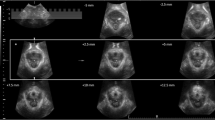Abstract
Levator ani muscle trauma is a common consequence of vaginal childbirth and detectable on digital vaginal palpation. To ascertain validity and reproducibility of this test, we saw 110 women for an interview, prolapse staging, digital vaginal palpation by two blinded examiners and four-dimensional translabial ultrasound. The mean age was 55.5 years (range 17–85) and the median parity was 2 (range 0–8). Three patients could not be assessed, leaving 107 datasets representing 214 assessments of a right or left puborectalis muscle. Levator defects were found in 21 women (20%) with nine bilateral defects. There was agreement between assessors in 173/214 (81%), k = 0.411, signifying moderate agreement. Agreement with an independent blinded review of tomographic ultrasound data was k = 0.495. Even after substantial training, the agreement between assessors using digital palpation for the diagnosis of levator trauma remains only moderate. There seems to be a substantial learning curve. Palpatory detection of major levator trauma is less repeatable than identification by ultrasound.



Similar content being viewed by others
References
Dietz HP, Lanzarone V (2005) Levator trauma after vaginal delivery. Obstet Gynecol 106(4):707–712
Dietz HP, Steensma AB (2006) The prevalence of major abnormalities of the levator ani in urogynaecological patients. Br J Obstet Gynaecol 113(2):225–230
Dietz HP (2007) Quantification of major morphological abnormalities of the levator ani. Ultrasound Obstet Gynecol 29:329–334
Kearney R, Miller JM, Ashton-Miller JA, Delancey JO (2006) Obstetric factors associated with levator ani muscle injury after vaginal birth. Obstet Gynecol 107(1):144–149
Dietz HP (2007) Does delayed childbearing increase the risk of levator injury in labour? Aust N Z J Obstet Gynaecol 47:491–495
DeLancey JO, Morgan DM, Fenner DE, Kearney R, Guire K, Miller JM, Hussain H, Umek W, Hsu Y, Ashton-Miller JA (2007) Comparison of levator ani muscle defects and function in women with and without pelvic organ prolapse. Obstet Gynecol 109(2):295–302
Dietz HP (2007) Levator trauma and female pelvic organ prolapse. Int Urogynecol J 18(S1):S242
Gainey HL (1943) Post-partum observation of pelvic tissue damage. Am J Obstet Gynecol 46:457–466
Dietz HP, Hyland G, Hay-Smith J (2006) The assessment of levator trauma: a comparison between palpation and 4D pelvic floor ultrasound. Neurourol Urodyn 25(5):424–427
Kearney R, Miller JM, Delancey JO (2006) Interrater reliability and physical examination of the pubovisceral portion of the levator ani muscle, validity comparisons using MR imaging. Neurourol Urodyn 25(1):50–54
Bump RC, Mattiasson A, Bo K, Brubaker LP, DeLancey JO, Klarskov P, Shull BL, Smith AR (1996) The standardization of terminology of female pelvic organ prolapse and pelvic floor dysfunction. Am J Obstet Gynecol 175(1):10–17
Dietz HP (2004) Ultrasound imaging of the pelvic floor: 3D aspects. Ultrasound Obstet Gynecol 23(6):615–625
Landis R, Koch G (1977) A one-way component of variance model for categorical data. Biometrics 33:671–679
Dietz HP, Gillespie A, Phadke P (2007) Avulsion of the pubovisceral muscle associated with large vaginal tear after normal vaginal delivery at term. Aust N Z J Obstet Gynaecol 47:341–344
Krofta L, Kasikova E, Otcenasek M, Feyereisl J (2007) Pubococcygeus–puborectalis trauma after instrumental delivery: the use of 4D ultrasound in the evaluation of levator ani muscle. Ultrasound Obstet Gynecol 30(4):446
Steensma AB, Schweitzer KJ, Burger CW, Schouten WR (2007) Are anal sphincter injuries related to levator abnormalities? Ultrasound Obstet Gynecol 30(4):448
Weinstein MM, Pretorius D, Jung SY, Nager CW, Mittal RK (2007) Anatomic defects in the puborectalis muscle in women with fecal incontinence. Ultrasound Obstet Gynecol 30(4):637
Steensma AB, Konstantinovic ML, Domali E, Timmerman D, Deprest J (2007) Incidence and prevalence of levator abnormalities in women with an underactive pelvic floor contraction and pelvic floor symptoms. Ultrasound Obstet Gynecol 30(4):449
Otcenasek M, Krofta L, Baca V, Grill R, Kucera E, Herman H, Vasicka I, Drahonovsky J, Feyereisl J (2007) Bilateral avulsion of the puborectal muscle: magnetic resonance imaging-based three-dimensional reconstruction and comparison with a model of a healthy nulliparous woman. Ultrasound Obstet Gynecol 29:692–696
Adekanmi OA, Freeman R, Puckett M, Jackson S (2005) Cystocele: does anterior repair fail because we fail to correct the fascial defects? A clinical and radiological study. Int Urogynecol J, 16(S2):S73
Weinstein MM, Pretorius D, Nager CW, Mittal RK (2007) Inter-rater reliability of pelvic floor muscle imaging abnormalities with 3D ultrasound. Ultrasound Obstet Gynecol 30(4):538
Dietz HP (2007) The relationship between Oxford Grading of muscle strength and levator defects. Int Urogynecol J 19 DOI 10.1007/s00192-007-0491-9
Acknowledgements
This study was supported in part by the Betty Byrne Henderson Foundation, University of Queensland, Brisbane, Queensland, Australia.
Conflicts of interest
None.
Author information
Authors and Affiliations
Corresponding author
Additional information
An erratum to this article can be found at http://dx.doi.org/10.1007/s00192-008-0602-2
Rights and permissions
About this article
Cite this article
Dietz, H., Shek, C. Validity and reproducibility of the digital detection of levator trauma. Int Urogynecol J 19, 1097–1101 (2008). https://doi.org/10.1007/s00192-008-0575-1
Received:
Accepted:
Published:
Issue Date:
DOI: https://doi.org/10.1007/s00192-008-0575-1




